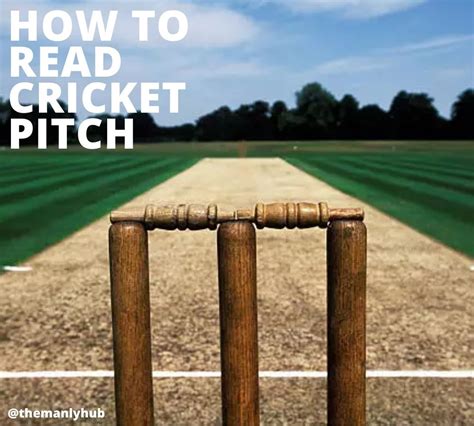Explore cricket pitch conditions, learn to identify different pitch types, analyze behavior, utilize insights for game improvement, and understand influencing factors.Understanding how to read a cricket pitch is essential for players, coaches, and enthusiasts alike. The pitch plays a pivotal role in determining the outcome of matches, influencing everything from batting performance to bowling strategies. In this article, we will delve into the fundamental aspects of cricket pitch conditions, guiding you through the process of identifying different pitch types effectively. You’ll learn to analyze pitch behavior for accurate predictions and discover how to leverage these insights to enhance your game. Additionally, we will discuss various factors impacting pitch conditions and their subsequent effect on game outcomes. Whether you’re a seasoned player or a budding cricket fan, mastering the art of reading a pitch will elevate your understanding and enjoyment of this beloved sport. Let’s uncover the secrets behind cricket pitch analysis!
Understanding The Basics Of Cricket Pitch Conditions
To truly master the game, understanding how to read a cricket pitch is essential. The pitch plays a pivotal role in determining the outcome of a match, influencing bowlers, batsmen, and the overall game strategy. Here, we will delve into the fundamental aspects of pitch conditions that every player should consider.
Cricket pitches can be classified based on their surface texture, moisture content, and grass cover. Each of these characteristics can significantly affect how the ball behaves upon delivery, making it crucial to assess them accurately.
How to identify a dry, cracked surface signals a pitch that will likely assist spinners, while a green and moist pitch typically favors fast bowlers. Understanding the condition of the pitch at the start of the game can provide significant insights into how to approach batting and bowling strategies throughout the match.
A pitch can also change over time. For instance, it may start with a hard and bouncy surface, but as the game progresses, wear and tear can lead to cracks or uneven bounce. Observing these changes is vital for adapting gameplay effectively. Players should pay attention to elements such as:
- Color: A darker pitch usually indicates moisture, while a lighter gray may suggest dryness.
- Texture: The roughness of the surface can hint at how much spin or pace the ball will receive.
- Layers: Different soil layers can affect the grip and bounce of the ball.
Recognizing these basic features of cricket pitch conditions is key for players seeking to enhance their performance and make informed decisions throughout the match. The ability to adapt your strategy based on your observations will provide a competitive advantage, making it easier to capitalize on favorable conditions and navigate challenging ones.
How To Identify Different Pitch Types Effectively
Identifying different pitch types is crucial for players and coaches looking to adapt their strategies to the unique playing conditions. Here are some key aspects to consider when determining the type of pitch you are dealing with:
Crumble and Deteriorate
As matches progress, most pitches will show signs of wear and tear. Observing the initial state of the pitch compared to later stages can highlight how the surface reacts over time. A pitch might provide a great batting surface in the first innings but can crumble, making it tricky for batters in subsequent innings.
Color and Texture
The color and texture of the pitch can indicate its type and behavior. Typically, a green pitch (with more grass) will favor bowlers, while a dry, cracked pitch is often advantageous for spinners. Pay attention to these visual clues:
| Pitch Type | Description | Impact on Play |
|---|---|---|
| Green Pitch | Fresh grass covering, slightly damp | More seam movement for fast bowlers |
| Dry Pitch | Hard, cracked surface, little to no grass | Ideal for spin bowlers as it turns |
| Dusty Pitch | Very dry, fluffy top layer, lots of cracks | Substantial turn and unpredictable bounce |
| Bouncy Pitch | Hard surface with uniform texture | Encourages consistent bounce, favorable for batsmen |
Weather Conditions
The weather can significantly affect pitch conditions. Rain can soften the surface, while sunshine can dry it out and make it harder. Analyzing how recent weather conditions might have altered the pitch can help you assess how to play on it.
Wear Patterns
Throughout a match, areas of the pitch will wear differently based on the players’ actions. Observing where bowlers have bowled and how batters have played can give insights into the likely behavior of the pitch as the game progresses.
By following these strategies on how to effectively identify different pitch types, players can enhance their understanding of the game and make more informed decisions during play.
Analyzing Pitch Behavior For Accurate Predictions
Understanding how to analyze pitch behavior is crucial for making accurate predictions during a cricket match. By observing and interpreting the nuances of the pitch, players and analysts can create strategies that can lead to success on the field.
Firstly, consider the pitch’s texture. A dry, cracked surface usually indicates that the pitch may break more as the game progresses, favoring spin bowlers. Conversely, a green, moist pitch is generally more conducive to fast bowlers, as it offers bounce and movement.
The level of wear and tear on the pitch is also vital. Typically, the condition of the pitch changes as the match unfolds. Observing how the ball reacts after several overs can provide insights. For instance, if a batsman starts getting a lot of deliveries that turn or seam excessively, it suggests the pitch is deteriorating, which may affect both batters and bowlers differently—another how to aspect that can help in planning the innings.
Weather conditions should never be ignored. Factors such as humidity can impact how the pitch behaves. For instance, greater humidity can aid swing bowlers, making the conditions more favorable for fast bowling. A careful observation of the skies at the start of the match and throughout its duration can significantly enhance your understanding and predictions.
In addition, watching how the ball interacts with the surface gives valuable information. If the ball is consistently bouncing along the same length without deviation, it suggests the pitch is true with minimal variance. However, if batsmen start getting inconsistent bounces or excessive seam movement, it’s crucial to note that as it may influence the gameplay dynamic.
Furthermore, analyzing trends from previous matches played on the same pitch can offer historical context that is beneficial. Look into how teams typically perform on specific pitches, and identify any patterns in pitch behavior that could inform current predictions.
By mastering these techniques and applying them consistently, players, coaches, and analysts can gain a significant edge, enhancing their understanding of how to navigate various pitch conditions effectively.
How To Use Pitch Insights To Improve Your Game
Understanding how to read a cricket pitch is essential for players looking to enhance their performance. Here are some practical tips on how to use pitch insights effectively:
- Assess the Pitch Early: Take note of the pitch conditions during the toss and before the game starts. Observing its color, dryness, and any cracks can provide valuable clues.
- Adapt Your Technique: Based on the type of pitch identified, adjust your batting or bowling technique. For instance, on a spinning pitch, focus on using your feet to create angles, while a seaming pitch may require a tighter bowling line.
- Utilize Analytics: Use statistical data and pitch maps from previous matches. Understanding how the pitch behaved previously can give insight into how it may play today.
- Collaborate with Team Members: Share observations with teammates. Discussing different perspectives can lead to a more rounded understanding of the pitch and how to approach it collectively.
- Practice on Similar Surfaces: If possible, train on practice pitches that mimic the conditions you will face during a match. This will help you develop strategies and muscle memory.
- Stay Informed: Watch expert analyses and read articles or reports about past matches on the same pitch. This helps you stay ahead with a clearer mind on pitch behavior.
- Mindset Shift: Cultivating a positive mindset about the pitch can influence performance. Rather than seeing tricky conditions as a challenge, view them as an opportunity to showcase adaptability.
By incorporating these strategies about how to utilize pitch insights, players can significantly elevate their game, enhance decision-making, and respond better under varying conditions.
Factors Impacting Pitch Conditions And Game Outcomes
Understanding the various factors that influence pitch conditions is crucial for players, coaches, and fans alike. Here are some key elements that can significantly affect how the pitch behaves during a cricket match:
- Weather Conditions: Rain, humidity, temperature, and wind can all have a major impact on the pitch. For instance, damp conditions can help seam bowlers, while hotter days may dry the pitch out, favoring spinners.
- Soil Composition: The type of soil used to create the pitch influences how it will break down over time. Clay-rich soils tend to retain moisture, while sandier soils dry out quicker, leading to variances in bounce and spin.
- Grass Coverage: The amount and type of grass on a pitch can determine its behavior. A green, well-grassed pitch tends to support seam bowling, while a bare pitch may assist spinners as the match progresses.
- Usage of the Pitch: A pitch that has been used for multiple matches can wear down differently. The deterioration over time affects bounce, pace, and turn.How to monitor how frequently a pitch is used can provide insights into its expected behavior.
- Preparation Techniques: How the pitch is prepared before a match plays a deciding role. Curation methods such as rolling, watering, and covering impact its hardness and level of moisture.
- Match Format: The style of the game—be it Test, ODI, or T20—can shift how the pitch is used. Pitches may be prepared more favorably for high-scoring T20 games compared to the traditional format of Test matches.
By analyzing these factors effectively, players and teams can gain a competitive edge, adjust their strategies accordingly, and maximize their chances of success on the field.
Frequently Asked Questions
What are the key factors to consider when assessing a cricket pitch?
Key factors include moisture levels, grass cover, and the overall hardness of the surface. These factors can heavily influence the behavior of the ball.
How can the weather affect pitch conditions?
Rain can make the pitch softer, potentially resulting in slower play, whereas dry weather can make the pitch harder and faster. Humidity can also affect how the ball behaves.
What does a green pitch indicate for bowlers?
A green pitch generally indicates that there is more grass and moisture, which can assist seam bowlers by providing movement off the surface.
What can batsmen expect from a dry pitch?
On a dry pitch, batsmen can usually expect good bounce and pace, making it easier for them to score runs as the ball may not deviate much.
How should teams adjust their strategies based on pitch conditions?
Teams should select their playing XI based on the pitch—opting for more spinners on dry pitches and more seamers on greener pitches. Batting order and shot selection should also be tailored.
What role does pitch deterioration play in a match?
As the match progresses, a pitch can wear down, creating uneven bounce and spin, which can significantly favor bowlers and alter a team’s strategy.
How can players practice reading a pitch effectively?
Players can practice by observing different pitches in various conditions, taking notes during matches, and gaining experience in assessing pre-match pitch reports.









